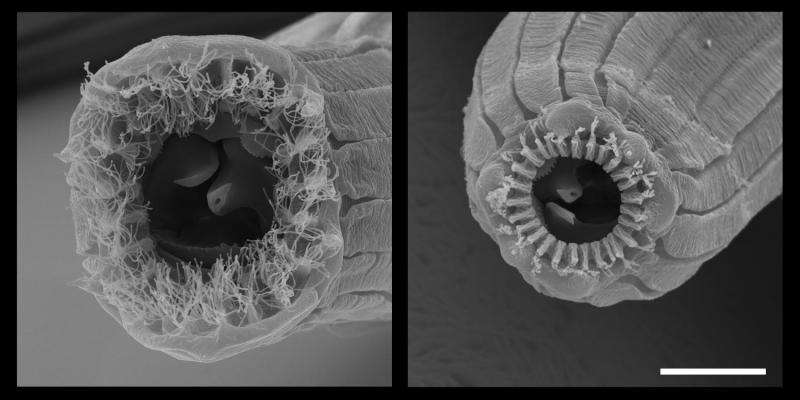January 18, 2016 report
Nematodes with five distinct forms found

(Phys.org)—An international team of researchers has found that at least one type of nematoad exhibits five distinct forms—each different enough that the microscopic worms were initially thought to be of different species. In their paper published in the journal Science Advances, the team describes their study of the worms that live in South Africa, Vietnam and on La Réunion Island and possible reasons for such diversity among a single species.
As the team notes, it is not uncommon for a single species to have many forms, dogs are one good example—other animals have different coat colors or wing patterns, depending on where they live, etc. But it is unusual for a single species to exist in as many as five different forms where they are so different it is difficult to make them out as from the same species. In this case, the nematoads are of a type that live inside of figs—they are carried to their home when young, by wasps. As they grow, they can take on one of five different forms depending on the conditions they find inside the fig—most of the differences are in the way the mouth is structured. If there are other competing nematoads of another species in a single fig, for example, the worms grow a lot of teeth and survive by eating the other worms. Those that land in nematoad-free figs, on the other hand, instead grow mouths that are suitable for eating microbes.
As to why the nematoads developed such diversification abilities, the team suggests it has to do with their isolated existence—they equate individual figs to islands, where a young nematoad is wholly at the mercy of its environment, which appears to be of five different major varieties. They note also that few nematoads actually manage to colonize new fruit, thus any species able to do so would naturally need to be able to take advantage of what is found once it arrives. They add that they have also found three related nematoad species that also have five phenotypes, which suggests the characteristic may not be as rare as was initially thought. They suggest there might be some species that are able to take on even more than five forms.
More information: V. Susoy et al. Large-scale diversification without genetic isolation in nematode symbionts of figs, Science Advances (2016). DOI: 10.1126/sciadv.1501031
Abstract
Diversification is commonly understood to be the divergence of phenotypes accompanying that of lineages. In contrast, alternative phenotypes arising from a single genotype are almost exclusively limited to dimorphism in nature. We report a remarkable case of macroevolutionary-scale diversification without genetic divergence. Upon colonizing the island-like microecosystem of individual figs, symbiotic nematodes of the genus Pristionchus accumulated a polyphenism with up to five discrete adult morphotypes per species. By integrating laboratory and field experiments with extensive genotyping of individuals, including the analysis of 49 genomes from a single species, we show that rapid filling of potential ecological niches is possible without diversifying selection on genotypes. This uncoupling of morphological diversification and speciation in fig-associated nematodes has resulted from a remarkable expansion of discontinuous developmental plasticity.
Journal information: Science Advances
© 2016 Phys.org




















